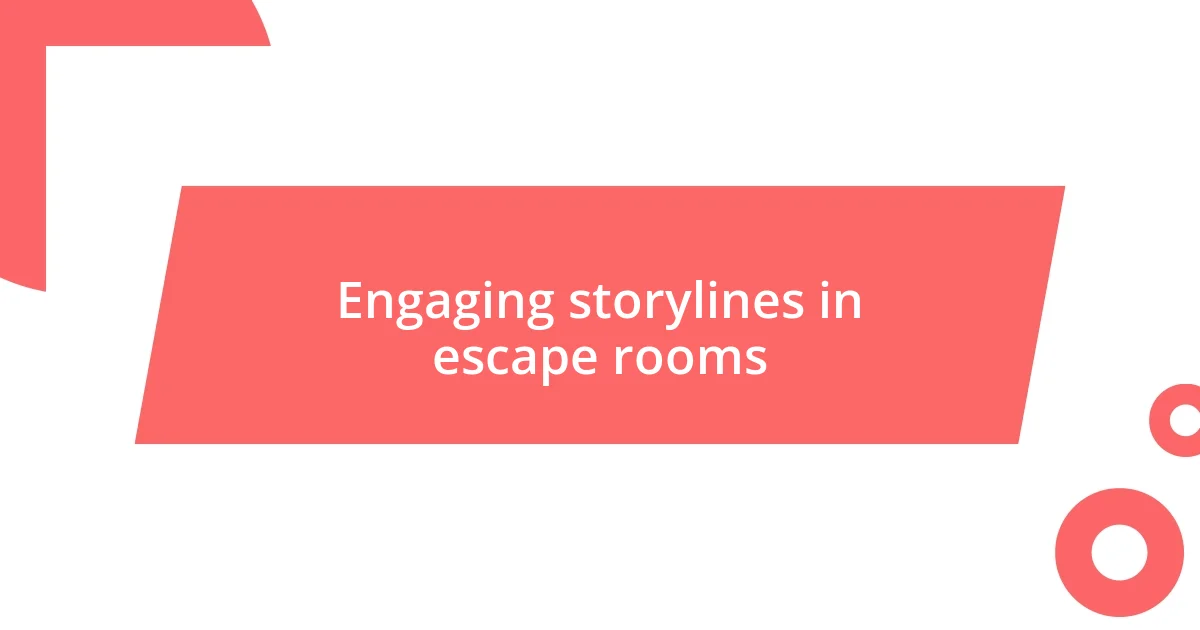Key takeaways:
- Escape rooms enhance teamwork and communication, fostering camaraderie and allowing players to combine their unique skills to solve puzzles together.
- Engaging narratives and diverse themes create immersive experiences that evoke strong emotions and add depth to the problem-solving process.
- Escape rooms promote critical thinking and adaptability, enabling participants to develop valuable problem-solving skills that extend beyond the game setting.

Reasons to play escape rooms
Escape rooms are one of my favorite ways to bond with friends and family. I remember the first time I tried one; the thrill of working together to solve puzzles and find clues truly brought us closer. There’s something about standing shoulder to shoulder with others as we race against the clock that transforms ordinary moments into lasting memories.
Beyond just teamwork, escape rooms tap into our natural curiosity and love for adventure. There’s that palpable excitement in the air as you step into a themed room, and suddenly you’re part of a story. Have you ever felt that rush of adrenaline when you finally crack a difficult puzzle? It’s exhilarating—like being the hero of your own movie.
I also enjoy the mental challenge escape rooms provide. They push you to think outside the box and tap into skills you might not even know you had. It’s a rewarding experience to see how each person contributes in their unique way, whether it’s spotting a hidden key or deciphering a code. Why settle for a mundane night in when you can test your wits and have fun with friends?

Benefits of teamwork in games
Working as a team in escape rooms fosters a sense of camaraderie that can be incredibly rewarding. I remember a time when we were stuck on a particularly tough riddle. Rather than feeling frustrated, we began brainstorming ideas and bouncing concepts off each other, which not only helped us solve the puzzle but also created a sense of shared victory. Those moments of triumph, ignited by collaboration, strengthen relationships and leave you feeling empowered.
Here are some benefits of teamwork in games like escape rooms:
- Enhanced Communication: Players learn to express their thoughts and strategies clearly, which is essential in high-pressure situations.
- Diverse Skillsets: Working together brings different strengths to the table, allowing teams to tackle challenges in a variety of ways.
- Supportive Environment: Team members encourage each other, which can boost confidence, especially for those who may be less comfortable in competitive settings.
- Shared Accountability: In these games, everyone plays a role, creating a collective responsibility for the outcome.
- Joyful Resilience: Overcoming setbacks as a team fosters a sense of resilience, teaching players how to cope with challenges together.

Problem solving skills development
When I first stepped into an escape room, I had no idea how much I would grow in my problem-solving abilities. Each puzzle requires a unique approach, and often, you need to collaborate with your teammates to find a solution. I recall one instance where my group faced a lock that seemed impossible to crack. Just when frustration was creeping in, someone suggested we look at it from a different angle, literally and figuratively. In that moment, we discovered the missing piece—a clue hidden in plain sight—illustrating how fresh perspectives can yield unexpected results.
The fast-paced environment of escape rooms also promotes critical thinking. I’ve found that navigating these challenges helps sharpen my ability to analyze situations quickly. As the clock ticks down, I’ve learned to prioritize tasks, deciding which puzzle needs attention first, which can be pivotal in beating the time limit. This ability to assess and react swiftly has translated into my daily life, especially at work where quick decision-making is crucial.
At the heart of every escape room is the thrill of the unknown. I’ve experienced that delightful moment of clarity when everything clicks into place, like the pieces of a jigsaw puzzle coming together in my mind. It’s not just about solving individual puzzles; it’s about intertwining them into a cohesive narrative that drives the entire experience forward. That’s the beauty of it—each obstacle conquered elevates my confidence, making me more eager and ready to tackle the next challenge that life throws my way.
| Aspect | Details |
|---|---|
| Collaboration | Encourages team discussions leading to insightful problem-solving. |
| Critical Thinking | Prioritizing tasks and analyzing scenarios under pressure enhances quick decision-making skills. |
| Fresh Perspectives | Looking at challenges from various viewpoints can reveal hidden solutions. |

Engaging storylines in escape rooms
The storylines in escape rooms create an unforgettable adventure that draws players into a world far removed from everyday life. I remember stepping into a pirate-themed room, where we became crew members on a quest for hidden treasure. The well-crafted narrative had me fully invested, as I envisioned the high seas and a long-lost fortune awaiting us, which transformed the entire experience from a game to a thrilling tale—making every clue feel like a step deeper into a captivating story.
What I often find fascinating is how these narratives can evoke real emotions. In one instance, we entered a room themed around a haunted mansion. The eerie ambiance and chilling storyline had us on edge, each puzzle steeped in the mansion’s tragic history. As we progressed, the emotional weight of the story amplified our sense of urgency. I couldn’t help but wonder, how can a simple puzzle bring about such intense feelings? It’s a testament to how well-constructed storylines can deepen our connection to the game, leaving us not just to solve puzzles, but to unfold a tale that resonates with us personally.
Engaging storylines serve as the backbone of the escape room experience, making challenges feel meaningful rather than just a series of tasks. I’ve participated in rooms where the plot twists kept us guessing, transforming our strategy in real-time. In one particularly memorable game, just as we thought we understood the narrative, a surprise element revealed that we were part of a much larger conspiracy. Moments like that make me question how narratives in games could shape our understanding of teamwork and trust among one another, sparking discussions long after we step out of the room.

Variety of themes and designs
There’s something truly exhilarating about the diverse themes and designs found in escape rooms. I remember walking into a sci-fi themed room, where the glowing lights and metallic props transported us to a futuristic spaceship. Each element was meticulously crafted, creating a rich atmosphere that enhanced the overall experience. The way these themes are woven into the puzzles not only makes the challenges engaging but also adds layers to the story we’re immersing ourselves in.
Sometimes, I think about how different themes can evoke different emotions. For instance, in a medieval dungeon setting, the ominous sounds of creaking chains made my heart race. As we searched for clues amidst the torches and stone walls, the adrenaline fueled our urgency to escape. How could something as simple as decor and ambiance cause such a heightened sense of thrill? It’s fascinating to realize that the combination of visual design and storytelling can amplify our emotional responses, turning a mere game into a gripping adventure.
What I appreciate most is the way these varied themes invite players from all walks of life to join in the experience. One evening, I participated in a whimsical fairy tale-themed escape room, where bright colors and quirky puzzles created a lighthearted atmosphere. It was a refreshing change, and I was surprised by how much fun we had solving puzzles that involved enchanted objects and magical spells. The diversity in themes allows everyone to find something that resonates with their interests, making escape rooms a truly inclusive and enjoyable experience.

Recommended escape room experiences
When it comes to recommended escape room experiences, I can’t help but highlight my adventure in a detective-themed room. The moment we stepped in, we were enveloped in a noir atmosphere, complete with vintage décor and soft jazz playing in the background. Piecing together clues felt like we were solving a real-world mystery, which sparked an unspoken camaraderie among us. I often reflect on how such immersive environments can elevate the teamwork aspect. How many times do we find ourselves problem-solving together in such a compelling context outside of an escape room?
One of my favorite experiences was in an escape room designed around an ancient Egyptian tomb. The thrill of uncovering hidden artifacts and deciphering hieroglyphics had me on the edge of my seat. I vividly remember the moment we uncovered a sarcophagus, with heart rates accelerating as we wondered what might be inside. That heart-thumping suspense really made me appreciate how much atmosphere can amplify emotions. Isn’t it incredible how a simple room can simulate both tension and excitement, turning us into true adventurers?
For a more whimsical touch, I recommend a room themed around a fun carnival. Bright colors, engaging puzzles, and even a cheeky clown prop made it feel like a delightful playground for problem solvers. I was amazed at how these lighthearted challenges could bring out so many laughs amongst our team while engaging our minds. At what other point do you get to tackle intellectually stimulating content in such a goofy, carefree environment? It showcases just how diverse escape room experiences can be—there’s genuinely something for everyone!













